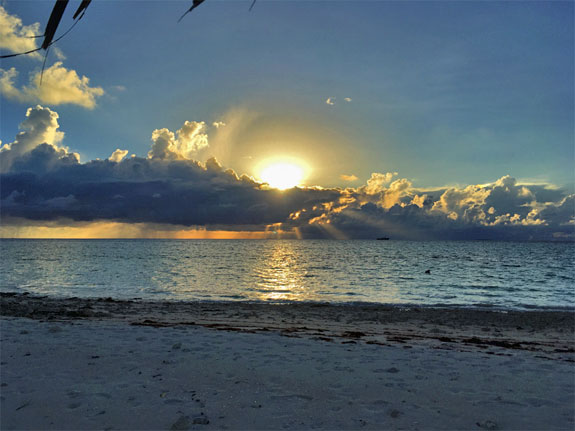Tuvalu National Library and Archives
Funafuti, Tuvalu, Mar. 23 - Apr. 6, 2017
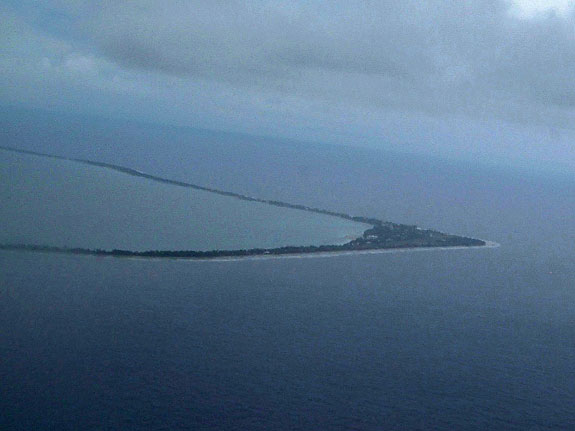
On my Fiji Airways approach to the atoll of Funafuti, Tuvalu, I could not believe my sleepy eyes as I stared at a tiny speck of land shaped like a boomerang. My first thought, or rather question, that quickly came to mind was- where on earth are we going to land? As we got closer to the island, I lost sight of the land. It seemed that we would be landing on water. However, the plane gently touched down and my fifteen-hour journey from California had finally come to an end. Although I live on the same ocean as the Pacific Islands, it always amazes me how big the Pacific Ocean is when I travel across it. Nevertheless, the journey may have ended but the adventure was just beginning. Projects are always adventures (especially in places that I have never been before) because no matter how much planning I do, inevitably there will be a myriad of surprises that spring up unexpectedly.
I met my colleague Noa Tapumanaia (who is the Chief Librarian and Archivist) at the airport and then walked the 25 yards to the Esfam Lodge where I would be staying for the next couple of weeks. Despite my tiredness, I was anxious to see the Tuvalu National Library and Archives and quickly dropped off my bags in my room. I then hopped on the back of Noa's scooter (everyone drives a scooter on the island) and we headed to the archives. It was a Thursday afternoon and the work week was winding down because Fridays are usually a half-day for the employees of the Ministries. Instantly, I met the three staff members who would be helping me with the project that we titled, “Appraising, Processing and Preserving the Public Records Collection at the Tuvalu National Library and Archives.” The staff members that would be helping me were Kana Teafiula, Librarian, and Assistant Librarians, Fagaatia Niko and Mamao Tafao, respectively.
The Tuvalu National Library and Archives building was a one-story building that was built almost forty years ago. Over the past few years there has been a desire to build a new library and archives facility because space is definitely at a premium. The library takes up most of the space in the building while the archives was composed of two rooms which includes an office and a very small repository of shelves teaming with collections. The boxes of archival supplies that I had been sending since the beginning of the year were also stacked in every corner of the two rooms. Unfortunately, these were not small boxes, thus making it difficult to move throughout the two rooms.
On Friday, March 24, I attended a devotion at the Ministry of Education, Youth and Sports' office which the library and archives falls under. It was at the Ministry Headquarter building where all the ministry offices reside and was probably the only three-story building on the island. The devotion is conducting every Friday morning and consists of a prayer, song and some inspirational speech. This was followed by a series of updates from department leaders. I introduced myself and told everyone the reasons why I was in Tuvalu, although most of the attendees already seemed to know- word travels fast on a small atoll. Here, was where I met Talavai Iona who was the Permanent Secretary of the Ministry. Mr. Iona appeared to be very keen on the National Library and Archives and the importance of the library and archives. He was also a big advocate of its needs, being completely aware of the inadequacies of the current building. He was enthusiastic about the possibilities of finding land to build a new building to house the library and archives' growing collections. It was encouraging for me to witness this enthusiasm because in many Pacific Islands countries, it was sometimes difficult to get ministries to understand the importance of archives.
After lunch on every Friday, all employees of the nine Ministries come together at the airport for inspiring or information talks, exercise and then play each other in some kind of sporting game. The Tuvalu government believed that this would help reduce obesity issues in the country. On my first Friday I joined in a game of volleyball which was played on the runway of the airport. The airstrip was the center of activity on the island because it was the only spot on the island that contained enough space. The runway is used for playing rugby, soccer, volleyball, walking and social gatherings. On my second Friday during my stay I joined our Ministry in picking up trash along the airstrip after the exercise portion of afternoon's itinerary. Each of the nine Ministries was given a portion of the runway. Although it sounds like hot work (and it was), it was actually a jovial, good time as everyone had a good sense of humor about the activity.
Over the weekend I worked on policies and guidelines for the archives. The archives was devoid of these documents such as an Archive Guideline, Collection Policy and a Preservation Policy. We felt it would be prudent to have these because not only were the collections in the archives are growing, but the interest in the archives was also getting more popular. Additionally, having these guidelines and documents will help with appraising records, as well as it will help staff and stakeholders understand what is expected of them when it comes to preserving and accessing records. The guidelines and policies were drafted generically but with the point-of-view of a Pacific Islands cultural heritage organization. The next step would be for Noa to meet with his staff and appropriate members of the Ministry of Education to re-write the policies specifically for their archives. This may take some time, but at least the archives has something to go by for the time being- even the documents in their generic form will be useful until the staff finds time to concentrate on revisions.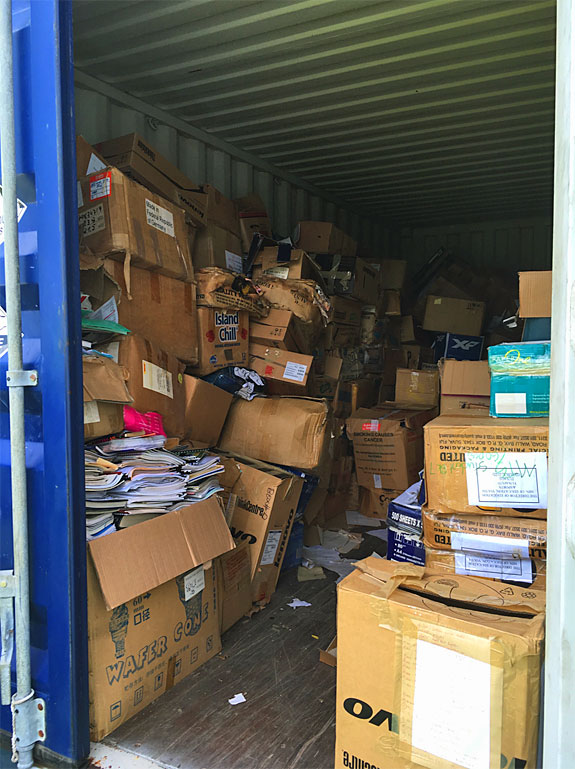
On the Monday the heart of the project began which was to process and preserve the Public Records Collection. I did not realize until I got to Funafuti that the Public Records encompassed all the records, especially modern records, of the nine Ministries. We visited a 25-foot container that was placed at the end of the airstrip, a two-minute scooter rider from the library and archives building. I also did not realize that the records were being stored in a container, and once we opened it I instantly saw how the next two weeks were going go be like. Fortunately, I have seen containers full of records before in other Pacific Islands, and thus I was not too intimidated by the sight. The problem was that with most containers, Ministries simply place the records in the container without any rhyme or reason. This was no different in Tuvalu.
When I returned home, I thought about the container and wished that I had organized it first. I believed that organizing the container would give the staff more space inside and make it easier to enter and exit it. Plus, records would not be crushed, and they staff could easily grab collections quicker and easier for processing. Thus, I recommended to Noa to:
1. Obtain a couple of volunteers - the more the better, but try to get at least two volunteers.
2. Pull everything outside the container. This probably sounded crazy. But believe me, it would be so much easier to organize all those boxes.
3. Now the staff and volunteers can organize and appraise the records. When placing boxes back in the container, put like records together. For example, put all the Ministry of Health boxes together, etc. Then, they will know what they have in the container and which collections (Ministries) will have priority.
Also, at this point, they should try to stack boxes full of library books together, and ask what books the library truly wants to keep or discard. The collections that we processed during the project can also be placed back in the container, keeping them together. I also recommended that they try not to stack more than three boxes high because this can cause damage to the boxes.
4. This would also be the time to discard boxes and records that they felt the archives did not need or want. For example, we came across several boxes of examination papers that are not valued. There were also lots of fliers, school booklets, etc. that can be discarded or passed out to patrons or schools.
5. The container had a lot of loose papers and I suggested that they place loose items with appropriate Ministry collections. If they do not belong to a ministry, stack like loose records together, and appraise. There were a lot of issues of a Tuvaluan newsletter that I think will have great value but were strewed all over the container. These should be collected and processed together. Hopefully, they will have the complete volume run of this newsletter. Time will tell.
In the afternoon we were able to borrow a car from the Ministry and go back to the container and pull some records to process. We quickly pulled boxes from the Ministry of Finance and brought back about seven of them to the library where we set up a table for processing. It was a good thing that we got the records back to the library so quickly, as it started to rain. It does not just rain in Tuvalu, it pours!
The collection that we brought back specifically consisted of records from the only hotel on the island called the Vaiaku Lagi Hotel. Arguably, perhaps, this was not the most important collection, but the records did have some historical value. Plus, it turned out to be an excellent training source for the staff of the library and archives. We set up a table in the middle of the library where we did the preserving and processing work. At this time there was lots of space because a row of book shelving was taken down and the staff was waiting for new shelving to be set-up. The shelving construction was delayed, however, because there was some parts missing and nobody knew when these parts were going to be found. Another issue was getting the work crew to come back to work on setting-up the new shelves because they went to another project of building a house.
After we cleared a worktable for our work, we placed our archival supplies such as new acid-free folders, boxes and cleaning tools near us for easy access. We then looked over the seven boxes that were numbered and pulled folders from box one. The records were fairly recent ranging from 2010 to 2016. Nevertheless, the folder that the records were housed in were dirty, tearing and in overall bad condition. We replaced each folder with new acid-free ones and rewrote the pertinent information from the old folder onto the new one. Each folder in the old box was already numbered, so we decided that this would be the way we would arrange the new box. We discussed certain ways to arrange a collection, but we decided to keep the arrangement simple. The records inside each folder were already placed in order by date, thus we acknowledged its original order making sure that they got filed in the same way within the new box. Some folders were overflowing with documents, so we decided to move them into two (sometimes even three) new folders. We felt that an overcrowded folder can compromise the items.
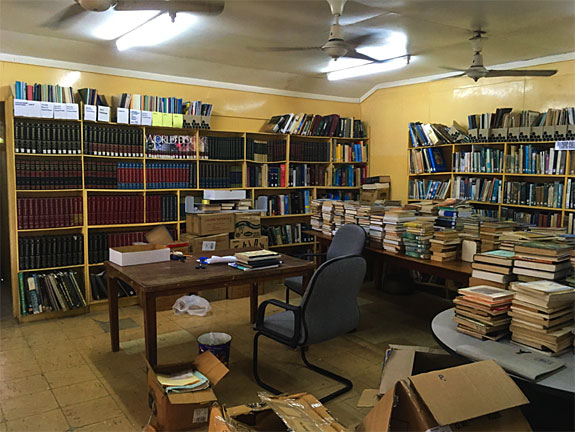
Before we moved the documents to the new folder, staff learned some basic preservation techniques. This included, cleaning dirt and dust off documents with small brushes, removing rusty paperclips and staples and unfolding folded items. Removing staples could easily be time-consuming. Thus, we decided to leave newer staples within the items because we believe that these records were now being better preserved in acid-free folders and boxes and the storage environment was not as intense as in the past. Over all, since the records were made fairly recent, most of the documents were in good shape. The staff learned that good preservation practices will only add to the longevity of the records.
It was my birthday on Tuesday, March 28. Out of all my visits to the Pacific Islands this was my first time I had ever been here on my birthday. The staff brought me a delicious cake which we enjoyed throughout the day. This was a very nice gesture and they certainly did not have to go through all the trouble. I had nothing planned for the day and had it my mind that it was going to be a lonely birthday since I was far from home. In the late afternoon we all went for an early dinner at a Chinese restaurant. I believe that there are four restaurants on the island and all of them serve Chinese food. Anyway, my birthdate turned out to be very awesome day after all.
For the rest of the week we continued to process records. We tackled approximately ten boxes from the Ministry of Health. Many of these records were about the planning and construction of the Princess Margaret Hospital which is the only hospital on the island. The boxes were full of folders that were numbered, so we arranged them in that order. These records were also a little older than the ones we worked on from the Ministry of Finance, and so there was a little more preservation work. We also came across documents that we deemed had a higher value such as hand-drawn illustrations. We gave these items extra protection by preserving them in a polyester sleeve. After working on a few boxes, I can see that the staff were getting more confident with processing and preserving records.
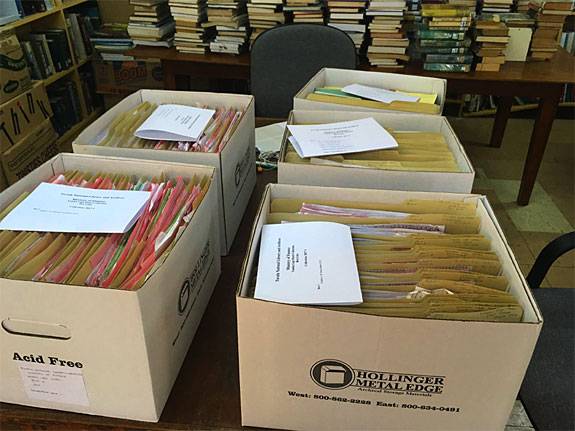
Describing the collection was the second part of our processing training. We discussed different description levels and decided that we would create box lists for each box. These lists described the contents to a series level, but we made a note if there was an item that may be worth digitizing, or we felt had a high value. Box lists are a very basic, yet practical form of description. We typed them in a computer and printed out a copy to place in each respective box. Another benefit of this is that staff now know what records they have and where to find them. This will make access to the material easier and quicker. The ultimate goal will be to create a Finding Guide for each collection. Unfortunately, this will have to wait because we do not know exactly what is in the container. There could be, for example, more boxes from the Ministry of Health that we did not see. A Finding Guide should be postponed until all the boxes from this Ministry are found and processed.
Although the project will continue through the rest of the year, I was quite pleased with the terrific start. The staff of the Tuvalu National Library and Archives was quite appreciative for the hands-on training. Being isolated with little resources, it is very difficult for them to acquire archival training. I was pleased to see how receptive they were to the training, and how eager they were to learn new techniques. I got the feeling that learning new archival practices do not happen very often with the group, and I was glad that they took full advantage of me being there to ask questions. Having a proactive staff will go a long way when it comes time to visualize, construct and open a new library and archives building, Hopefully, this will happen in the near future.